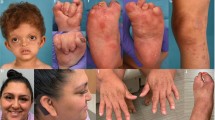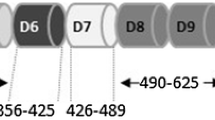Abstract
Ectodermal dysplasia is a highly heterogeneous group of disorders that variably affect the derivatives of the ectoderm, primarily skin, hair, nails and teeth. TP63, itself mutated in ectodermal dysplasia, links many other ectodermal dysplasia disease genes through a regulatory network that maintains the balance between proliferation and differentiation of the epidermis and other ectodermal derivatives. The ectodermal knockout phenotype of five mouse genes that regulate and/or are regulated by TP63 (Irf6, Ikkα, Ripk4, Stratifin, and Kdf1) is strikingly similar and involves abnormal balance towards proliferation at the expense of differentiation, but only the first three have corresponding ectodermal phenotypes in humans. We describe a multigenerational Saudi family with an autosomal dominant form of hypohidrotic ectodermal dysplasia in which positional mapping and exome sequencing identified a novel variant in KDF1 that fully segregates with the phenotype. The recapitulation of the phenotype we observe in this family by the Kdf1−/− mouse suggests a causal role played by the KDF1 variant.


Similar content being viewed by others
References
Arnold K, Bordoli L, Kopp J, Schwede T (2006) The SWISS-MODEL workspace: a web-based environment for protein structure homology modelling. Bioinformatics 22:195–201
Blanpain C, Fuchs E (2009) Epidermal homeostasis: a balancing act of stem cells in the skin. Nat Rev Mol Cell Biol 10:207–217
Carr IM, Johnson CA, Markham AF, Toomes C, Bonthron DT, Sheridan EG (2011) DominantMapper: rule-based analysis of SNP data for rapid mapping of dominant diseases in related nuclear families. Hum Mutat 32:1359–1366
Döffinger R, Smahi A, Bessia C, Geissmann F, Feinberg J, Durandy A, Bodemer C, Kenwrick S, Dupuis-Girod S, Blanche S (2001) X-linked anhidrotic ectodermal dysplasia with immunodeficiency is caused by impaired NF-κB signaling. Nat Genet 27:277–285
Fomenkov A, Zangen R, Huang Y-P, Osada M, Guo Z, Fomenkov T, Trink B, Sidransky D, Ratovitski EA (2004) RACK1 and stratifin target ΔNp63α for a proteasome degradation in head and neck squamous cell carcinoma cells upon DNA damage. Cell Cycle 3:1285–1295
Fuchs E (1990) Epidermal differentiation: the bare essentials. The Journal of Cell Biology 111:2807–2814
Guenet J, Salzgeber B, Tassin M (1979) Repeated epilation: a genetic epidermal syndrome in mice. J Hered 70:90–94
Herron BJ, Liddell RA, Parker A, Grant S, Kinne J, Fisher JK, Siracusa LD (2005) A mutation in stratifin is responsible for the repeated epilation (Er) phenotype in mice. Nat Genet 37:1210–1212
Holbrook KA, Dale BA, Brown KS (1982) Abnormal epidermal keratinization in the repeated epilation mutant mouse. J Cell Biol 92:387–397
Kall L, Krogh A, Sonnhammer EL (2004) A combined transmembrane topology and signal peptide prediction method. J Mol Biol 338:1027–1036. doi:10.1016/j.jmb.2004.03.016
Kallberg M, Margaryan G, Wang S, Ma J, Xu J (2014) RaptorX server: a resource for template-based protein structure modeling. Methods Mol Biol 1137:17–27. doi:10.1007/978-1-4939-0366-5_2
Koster MI (2010) p63 in skin development and ectodermal dysplasias. J Investig Dermatol 130:2352–2358
Koster MI, Roop DR (2004) The role of p63 in development and differentiation of the epidermis: tanioku kihei memorial lecture. J Dermatol Sci 34:3–9
Koster MI, Kim S, Mills AA, DeMayo FJ, Roop DR (2004) p63 is the molecular switch for initiation of an epithelial stratification program. Genes Dev 18:126–131
Lee S, Kong Y, Weatherbee SD (2013) Forward genetics identifies Kdf1/1810019J16Rik as an essential regulator of the proliferation–differentiation decision in epidermal progenitor cells. Dev Biol 383:201–213
Li Q, Lu Q, Estepa G, Verma IM (2005) Identification of 14-3-3σ mutation causing cutaneous abnormality in repeated-epilation mutant mouse. Proc Natl Acad Sci 102:15977–15982
Li Q, Sambandam SA, Lu HJ, Thomson A, Kim S-h LuH, Xin Y, Lu Q (2011) 14-3-3σ and p63 play opposing roles in epidermal tumorigenesis. Carcinogenesis 32:1782–1788
Milstone LM (2004) Epidermal desquamation. J Dermatol Sci 36:131–140
Mitchell K, O’Sullivan J, Missero C, Blair E, Richardson R, Anderson B, Antonini D, Murray JC, Shanske AL, Schutte BC (2012) Exome sequence identifies RIPK4 as the Bartsocas-Papas syndrome locus. Am J Hum Genet 90:69–75
Niemann C, Watt FM (2002) Designer skin: lineage commitment in postnatal epidermis. Trends Cell Biol 12:185–192
Pagnan NAB, Visinoni ÁF (2014) Update on ectodermal dysplasias clinical classification. Am J Med Genet Part A 164:2415–2423
Prasad GL, Valverius EM, McDuffie E, Cooper H (1992) Complementary DNA cloning of a novel epithelial cell marker protein, HME1, that may be down-regulated in neoplastic mammary cells. Cell Growth Differ 3:507
Shaheen R, Ansari S, Alshammari MJ, Alkhalidi H, Alrukban H, Eyaid W, Alkuraya FS (2013) A novel syndrome of hypohidrosis and intellectual disability is linked to COG6 deficiency. J Med Genet 50:431–436
Shamseldin HE, Maddirevula S, Faqeih E, Ibrahim N, Hashem M, Shaheen R, Alkuraya FS (2016) Increasing the sensitivity of clinical exome sequencing through improved filtration strategy. Genet Med. doi:10.1038/gim.2016.155
Truong AB, Kretz M, Ridky TW, Kimmel R, Khavari PA (2006) p63 regulates proliferation and differentiation of developmentally mature keratinocytes. Genes Dev 20:3185–3197
Westfall MD, Mays DJ, Sniezek JC, Pietenpol JA (2003) The ΔNp63α phosphoprotein binds the p21 and 14-3-3σ promoters in vivo and has transcriptional repressor activity that is reduced by Hay-Wells syndrome-derived mutations. Mol Cell Biol 23:2264–2276
Wright JT, Grange DK, Richter MK (2014) Hypohidrotic ectodermal dysplasia. In: Pagon RA, Adam MP, Ardinger HH, Wallace SE, Amemiya A, Bean LJH, Bird TD, Fong CT, Mefford HC, Smith RJH, Stephens K (eds) GeneReviews® [Internet]. Seattle (WA): University of Washington, Seattle; 1993–2016
Xu D, Zhang Y (2012) Ab initio protein structure assembly using continuous structure fragments and optimized knowledge-based force field. Proteins 80:1715–1735. doi:10.1002/prot.24065
Acknowledgements
We thank the study family for their enthusiastic participation. We also thank the Sequencing and Genotyping Core Facilities at KFSHRC for their technical help. This work was supported by KACST Grant 13-BIO1113-20 (FSA) and King Abdullah University of Science and Technology (KAUST) (STA).
Author information
Authors and Affiliations
Corresponding authors
Ethics declarations
Conflict of interest
On behalf of all authors, the corresponding authors state that there is no conflict of interest.
Additional information
H. E. Shamseldin and O. Khalifa contributed equally.
Electronic supplementary material
Below is the link to the electronic supplementary material.
439_2016_1741_MOESM1_ESM.pdf
Supplementary material 1 (PDF 429 kb) Figure S1. (A) Prediction of secondary structure (top) and disorder (bottom) for KDF1. F251 is identified by an asterisk. The grey underlined fragment was subjected to ab initio 3D structure prediction, resulting in the model shown in (B), where F521 is highlighted in green, and S218 is shown in yellow. The Quark TM score for the 3D model was 0.56 ± 0.08, and TM score of top 10 best models was 0.63 ± 0.07, indicating that the modeling procedure converged on highly similar models, and hence that the overall fold of the resulting model is close to reality
Rights and permissions
About this article
Cite this article
Shamseldin, H.E., Khalifa, O., Binamer, Y.M. et al. KDF1, encoding keratinocyte differentiation factor 1, is mutated in a multigenerational family with ectodermal dysplasia. Hum Genet 136, 99–105 (2017). https://doi.org/10.1007/s00439-016-1741-z
Received:
Accepted:
Published:
Issue Date:
DOI: https://doi.org/10.1007/s00439-016-1741-z




